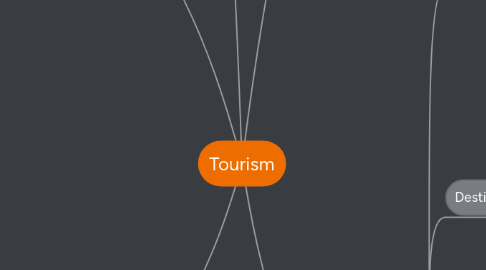
1. Factors
1.1. Demand
1.1.1. Disposable Income
1.1.1.1. Income left over after paying for necessities (rent, food, etc)
1.1.2. Free time
1.1.2.1. Advent of 'leave' as a concept as people moved from self-employment to being employed at companies
1.1.3. Demographics
1.1.3.1. growing healthy population (e.g. 'Grey nomads')
1.2. Destination
1.2.1. Infrastructure
1.2.1.1. Physical
1.2.1.1.1. Roads
1.2.1.1.2. Airport
1.2.1.1.3. Hotels
1.2.1.2. Social
1.2.1.2.1. xenophobia
1.2.2. Open skies agreements
1.2.2.1. agreements between states to allow for travel between them.
1.2.2.2. opposite example was when China required all commercial flights passing through previously international airspace to report to their flight control early in 2014. Many military forces refused, but commercial airlines quickly complied.
1.2.3. Deregulation
1.2.3.1. refers to the privatisation of airlines. consider what it means for a government to define the price of travel, or for there to be a National Airline
1.3. Technology
1.3.1. Communications
1.3.1.1. Internet
1.3.1.1.1. makes it easier for travellers to book tickets, hotels, find out information of destinations, etc.
1.3.1.2. CCTV
1.3.1.2.1. Perception of greater security, ease of mind for tourists
1.3.1.3. Mobile phones
1.3.1.3.1. reduces the barrier to entry for individual travel because you can now quickly contact embassies for help, check Google map if you're lost, or refer to apps
1.3.2. Transportation
1.3.2.1. Budget airplanes
1.3.2.1.1. increases access to smaller airports and destinations
1.3.2.1.2. makes it cheaper for people to travel (i.e. need less disposable income)
1.3.2.2. Faster planes
1.3.2.2.1. Easier for business tourists to travel for business
1.3.2.2.2. Saves time, and usually more fuel efficient
1.3.2.2.3. e.g. Boeing Dreamliner 787
1.3.2.3. Bigger planes
1.3.2.3.1. Can carry more passengers per flight
1.3.2.3.2. Makes each ticket cheaper
1.3.2.3.3. e.g. Airbus A380
1.3.2.4. Safer planes
1.3.2.4.1. Perception that it is easier and safer to travel
2. Impact
2.1. Economic
2.1.1. + Tourism receipts
2.1.2. - growing regional inequality
2.2. Social
2.2.1. + Preserve local culture
2.2.2. - Dilution of culture (markets in temples, shortening of rituals)
2.2.3. - Crime because it's easy to cheat and rob tourists (who usually don't know better)
2.2.4. - Conflict between locals and tourists (e.g. F1 weekend in Singapore and its subsequent jams and crowded trains)
2.3. Environmental
2.3.1. + Preservation of environment and animals (e.g. Savannah safaris/coral reefs)
2.3.2. - Vandalism and removal of 'souvenirs' (e.g. plucking flowers, trampling on roots)
3. Stakeholders
3.1. Governments
3.1.1. *SS point: tourism is an economic strategy for governments. IS IT SUITABLE FOR EVERY COUNTRY?
3.2. Locals
3.2.1. The sustainability of the tourism industry lies on whether or not locals will help run programmes, take care of the environment, and police/monitor behaviour
3.3. Travel industry
3.3.1. Of course, in addition to locals, the travel industry (including hoteliers, f&b, tour operators, etc) will need to properly educate tourists on social mores of the place they are visiting
3.3.2. Consider the role of foreign investors like Resorts World who invest in building physical infrastructure! How might they encourage tourism in a place?
3.4. Tourists
3.4.1. Tourists themselves have to take ownership and personal responsibility for their actions. A simple example of how this works is the ugly Singaporean tourist who litters overseas, but doesn't do so at home.
4. Drivers
4.1. Governments
4.1.1. Setting up of National Tourism Organisations
4.1.1.1. www.yoursingapore.com
4.1.2. investing in physical and social infrastructure
4.1.2.1. e.g. building theme parks (USS)
4.1.2.2. e.g. building casinos
4.1.2.3. e.g. Marina Bay Sands was a multi-billion dollar investment to try an earn $30billion in tourism receipts for Singapore
4.1.2.4. e.g. Night Safari is a programme in an existing building. We have to reinvent ourselves to continue making ourselves interesting to our potential 'customers': How do you feel about that?
4.1.3. creation of spectacles
4.1.3.1. E.g. F1 night race
4.1.3.2. E.g. New Year's countdowns
4.1.3.3. e.g. Light ups
4.2. Tour operators
4.2.1. selling of tour packages at travel fairs (e.g. NATAS)
4.3. Travel Writers
4.3.1. Reviews of experiences online can encourage or discourage travel
4.3.2. Traditionally refers to publications like Lonely Planet, but can now refer to TripAdvisor.com
4.4. Media
4.4.1. DOES NOT refer to advertisements made by travel agents or governments!!!!
4.4.2. may discourage travel if there is news about war or anything that may endanger the lives and safety of travellers (e.g. war)
5. types
5.1. Niche
5.1.1. e.g. Ecotourism
5.2. Mass
5.2.1. e.g. Package tours
5.3. categories of travellers
5.3.1. Facilities/MICE tourism
5.3.1.1. e.g. EXPO and Suntec Convention Centre
5.3.2. Culture/Heritage tourism
5.3.2.1. e.g. religious pilgrimages (the Hajj to Mecca; bathing in the Ganges in Varanasi; visiting the Vatican in Italy)
5.3.2.2. e.g. visiting UN World Heritage sites like Angkor Wat,
5.3.3. Conflict/Dark tourism
5.3.3.1. visiting sites of former death and conflict (e.g. the Cu Chi tunnels in Vietnam)
5.3.4. Scenic beauty/Honeypot tourism
5.3.4.1. often seasonal
5.3.4.2. e.g. climbing a volcano
5.3.4.3. e.g. Sakura season in Japan
5.3.4.4. e.g. Skiing often requires it to be winter
5.3.5. Space
5.3.5.1. tickets now on sale! (even though it's not technically possible yet)

